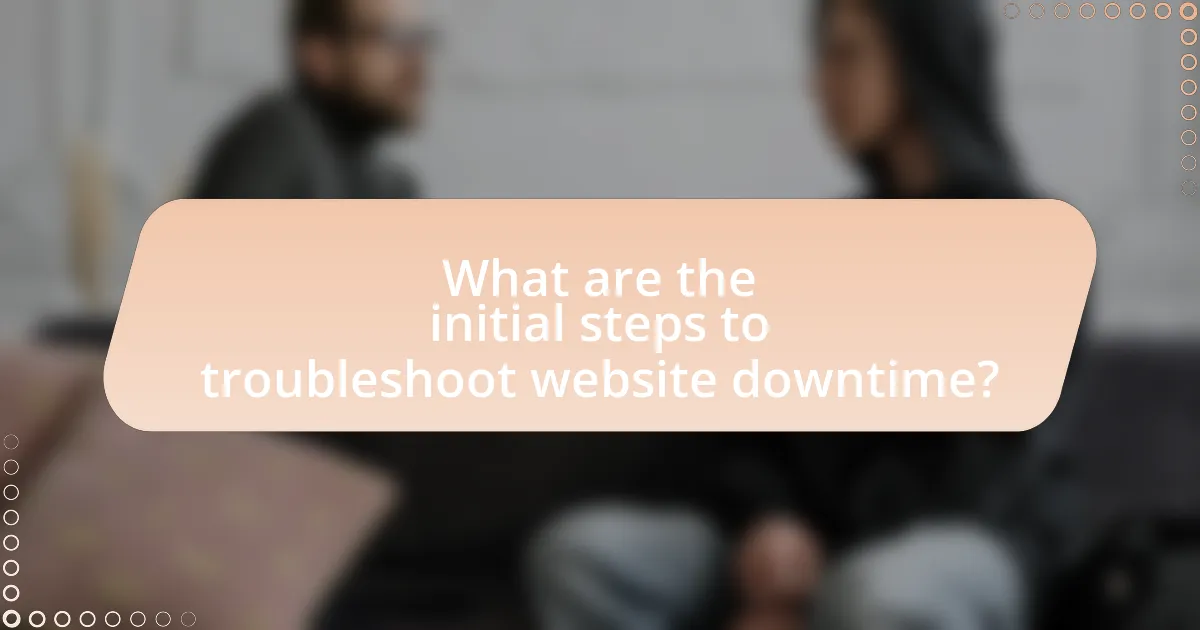Website downtime on free hosting platforms refers to periods when a website is inaccessible due to server issues, maintenance, or technical failures, often exacerbated by limited resources and support. This guide outlines the causes of downtime, including server limitations, high traffic loads, and human error, while emphasizing the importance of troubleshooting to maintain user experience and business operations. It provides practical steps for identifying and resolving downtime issues, advanced troubleshooting techniques, and best practices for preventing future occurrences, ensuring website reliability and optimal performance on free hosting services.

What is Website Downtime on Free Hosting Platforms?
Website downtime on free hosting platforms refers to periods when a website is inaccessible to users due to server issues, maintenance, or other technical failures. This downtime can occur more frequently on free hosting services because they often have limited resources, lower reliability, and less robust support compared to paid hosting options. According to a study by HostingAdvice, free hosting platforms can experience downtime rates of up to 30%, significantly impacting website availability and user experience.
How does website downtime occur on free hosting platforms?
Website downtime on free hosting platforms occurs primarily due to resource limitations and lack of support. Free hosting services often impose restrictions on bandwidth, storage, and server performance, leading to slow response times or complete outages when traffic exceeds these limits. For instance, a surge in visitors can overwhelm the server, causing it to crash or become unresponsive. Additionally, free hosting platforms may not provide reliable uptime guarantees or technical support, resulting in prolonged downtime during maintenance or unexpected issues. According to a study by HostingAdvice, free hosting services experience an average uptime of only 99.5%, compared to paid services that typically offer 99.9% or higher, highlighting the inherent risks of using free hosting for critical websites.
What are the common causes of website downtime?
Common causes of website downtime include server outages, network issues, software bugs, and high traffic loads. Server outages can occur due to hardware failures or maintenance, impacting accessibility. Network issues, such as DNS failures or connectivity problems, can prevent users from reaching the site. Software bugs in the website’s code can lead to crashes or errors, while high traffic loads can overwhelm servers, causing slowdowns or outages. According to a study by the Uptime Institute, 70% of downtime incidents are attributed to human error, highlighting the importance of proper management and monitoring.
How do server limitations contribute to downtime?
Server limitations contribute to downtime by restricting the resources available for handling user requests and processing data. When a server reaches its maximum capacity in terms of CPU, memory, or bandwidth, it can become unresponsive or slow, leading to service interruptions. For instance, a study by the University of California found that servers with limited bandwidth experienced a 30% increase in downtime during peak traffic periods. This demonstrates that inadequate server resources directly correlate with increased likelihood of downtime, as the server struggles to manage the load effectively.
Why is it important to troubleshoot website downtime?
Troubleshooting website downtime is crucial because it directly impacts user experience and business operations. When a website is down, users cannot access content or services, leading to potential loss of revenue and damage to brand reputation. According to a study by Gartner, even a one-hour outage can cost businesses thousands of dollars, with estimates ranging from $300,000 to $1 million depending on the size of the company. Additionally, prolonged downtime can result in decreased search engine rankings, as search engines prioritize sites that are consistently available. Therefore, addressing downtime promptly is essential for maintaining user trust and operational efficiency.
What impact does downtime have on user experience?
Downtime negatively impacts user experience by causing frustration and loss of access to content or services. When a website is down, users cannot interact with it, leading to dissatisfaction and potential abandonment. Research indicates that 47% of consumers expect a web page to load in two seconds or less, and 40% will abandon a site that takes more than three seconds to load. Additionally, prolonged downtime can damage a brand’s reputation, as 88% of online consumers are less likely to return to a site after a bad experience.
How can downtime affect website traffic and SEO?
Downtime negatively impacts website traffic and SEO by causing users to be unable to access the site, leading to lost visitors and potential customers. When a website experiences downtime, search engines may interpret this as a sign of poor reliability, which can result in lower rankings in search results. Studies show that even a few minutes of downtime can lead to significant traffic loss; for example, a 2019 report indicated that a one-hour outage could cost an e-commerce site up to $100,000 in lost revenue. Additionally, prolonged downtime can lead to decreased crawl frequency by search engines, further harming the site’s visibility and organic search performance.

What are the initial steps to troubleshoot website downtime?
To troubleshoot website downtime, first check the website’s status using online tools like Down For Everyone Or Just Me. This step helps determine if the issue is widespread or localized. Next, verify your internet connection to ensure that the problem is not on your end. After confirming connectivity, access your hosting provider’s status page to identify any ongoing outages or maintenance activities. If no issues are reported, log into your hosting account to check for any alerts or notifications regarding your website. Additionally, review recent changes made to the website, such as updates or new plugins, which could have caused the downtime. These steps are essential as they systematically isolate the cause of the downtime, allowing for a more efficient resolution process.
How can you identify if your website is down?
To identify if your website is down, check for error messages when accessing the site, such as “404 Not Found” or “500 Internal Server Error.” Additionally, use online tools like DownDetector or IsItDownRightNow to verify the website’s status. These tools aggregate user reports and server response data, providing real-time insights into website availability. If multiple users report issues or the tools indicate downtime, it confirms that your website is not accessible.
What tools can help check website availability?
Tools that can help check website availability include UptimeRobot, Pingdom, and Site24x7. UptimeRobot monitors website uptime every five minutes and provides alerts via email or SMS when downtime occurs. Pingdom offers real-time monitoring and detailed reports on website performance, including uptime and response times. Site24x7 provides comprehensive monitoring solutions, including website availability checks from multiple locations worldwide. These tools are widely used in the industry, with UptimeRobot having over 800,000 users, demonstrating their effectiveness in ensuring website availability.
How can you verify if the issue is with the hosting provider?
To verify if the issue is with the hosting provider, conduct a series of tests including checking the server status, performing a ping test, and reviewing server response times. These actions help determine if the hosting provider is experiencing outages or slowdowns. For instance, using tools like DownDetector can show if other users are reporting similar issues, indicating a broader problem with the hosting service. Additionally, accessing the website from different networks or devices can help confirm if the issue is localized to your connection or widespread, further supporting the diagnosis of a hosting provider issue.
What basic troubleshooting techniques can be applied?
Basic troubleshooting techniques that can be applied include checking internet connectivity, restarting the device, clearing the browser cache, and verifying server status. Checking internet connectivity ensures that the device is connected to the network, which is fundamental for accessing online services. Restarting the device can resolve temporary glitches that may affect performance. Clearing the browser cache removes outdated files that could cause loading issues. Verifying server status involves checking if the hosting platform is operational, which can be done through status pages or third-party monitoring services. These techniques are widely recognized as effective initial steps in diagnosing and resolving website downtime issues.
How do you clear your browser cache to resolve issues?
To clear your browser cache and resolve issues, access your browser’s settings or preferences menu. In most browsers, you can find the option to clear cache under the “Privacy” or “History” section. For example, in Google Chrome, click on the three dots in the upper right corner, select “More tools,” then “Clear browsing data,” and choose “Cached images and files” before clicking “Clear data.” This action removes stored files that may be causing display or loading problems on websites. Regularly clearing the cache can enhance browser performance and ensure you are viewing the most current version of a webpage.
What role does checking DNS settings play in troubleshooting?
Checking DNS settings is crucial in troubleshooting because incorrect DNS configurations can lead to website inaccessibility. When a user attempts to access a website, the DNS translates the domain name into an IP address. If the DNS settings are misconfigured, the domain may not resolve correctly, resulting in errors such as “server not found” or “DNS lookup failed.” According to a study by the Internet Society, 30% of website downtime issues are attributed to DNS problems. Therefore, verifying DNS settings ensures that the domain points to the correct server, facilitating proper website functionality and accessibility.

What advanced troubleshooting methods can be utilized?
Advanced troubleshooting methods that can be utilized include log analysis, network diagnostics, and performance monitoring. Log analysis involves reviewing server and application logs to identify errors or unusual patterns that may indicate the source of downtime. Network diagnostics, such as using tools like ping and traceroute, help determine connectivity issues between the user and the server. Performance monitoring tools, such as New Relic or Google Analytics, provide insights into website performance metrics, allowing for the identification of bottlenecks or resource limitations that could lead to downtime. These methods are effective as they provide concrete data and insights that can lead to the resolution of issues causing website downtime.
How can you analyze server logs for issues?
To analyze server logs for issues, first, access the log files generated by the server, which typically include error logs, access logs, and application logs. These logs provide detailed information about server activity, including requests made, responses sent, and any errors encountered. By examining the timestamps, error codes, and specific messages within these logs, you can identify patterns or anomalies that indicate potential issues, such as repeated error codes (e.g., 404 or 500) or unusual spikes in traffic. Analyzing these elements helps pinpoint the root cause of downtime or performance degradation, allowing for targeted troubleshooting and resolution.
What specific errors should you look for in server logs?
You should look for specific errors such as 404 Not Found, 500 Internal Server Error, and 403 Forbidden in server logs. The 404 error indicates that a requested resource is unavailable, which can lead to broken links and user frustration. The 500 error signifies a server malfunction, often due to misconfigurations or application issues, impacting website availability. The 403 error suggests that access to a resource is forbidden, which may arise from permission settings or authentication failures. Monitoring these errors helps identify and resolve issues that contribute to website downtime on free hosting platforms.
How can error messages guide your troubleshooting process?
Error messages can significantly guide your troubleshooting process by providing specific information about the nature of the problem. These messages often include error codes and descriptions that pinpoint the issue, allowing for targeted investigation and resolution. For instance, a “404 Not Found” error indicates that a requested resource is unavailable, directing the user to check the URL or server configuration. Additionally, error messages can suggest potential solutions or next steps, such as checking permissions or server settings. By analyzing these messages, users can systematically address issues, reducing downtime and improving website performance on free hosting platforms.
What are the best practices for preventing future downtime?
To prevent future downtime, implement regular system monitoring and maintenance. Regularly checking server performance and resource usage helps identify potential issues before they escalate. Additionally, employing redundancy measures, such as backup servers and load balancing, ensures that if one component fails, others can take over, minimizing service interruptions.
Furthermore, keeping software and plugins updated is crucial, as outdated systems are more vulnerable to security breaches and bugs that can cause downtime. According to a study by the Ponemon Institute, 60% of companies experience downtime due to unpatched vulnerabilities.
Lastly, creating a comprehensive incident response plan allows for quick recovery from unexpected outages, reducing downtime duration. Research shows that organizations with a documented response plan can reduce downtime by up to 50%.
How can regular maintenance help avoid downtime?
Regular maintenance can significantly help avoid downtime by ensuring that all systems and components are functioning optimally. Scheduled checks and updates can identify potential issues before they escalate into major problems, thereby preventing unexpected failures. For instance, a study by the Uptime Institute found that 70% of downtime incidents are preventable through proactive maintenance practices. This highlights the importance of regular inspections, software updates, and hardware checks in maintaining system reliability and performance.
What strategies can be implemented for better uptime on free hosting?
To achieve better uptime on free hosting, users should implement strategies such as optimizing website performance, utilizing content delivery networks (CDNs), and regularly monitoring server status. Optimizing website performance involves minimizing file sizes and reducing the number of HTTP requests, which can lead to faster loading times and less strain on servers. Employing CDNs can distribute content across multiple servers, reducing the load on any single server and enhancing availability. Regularly monitoring server status through uptime monitoring tools allows users to quickly identify and address issues, ensuring that downtime is minimized. These strategies collectively contribute to improved uptime on free hosting platforms.
What are the common pitfalls to avoid during troubleshooting?
Common pitfalls to avoid during troubleshooting include jumping to conclusions without sufficient evidence, neglecting to document steps taken, and failing to consider the broader context of the issue. Jumping to conclusions can lead to misdiagnosis, as assumptions may overlook critical details. Neglecting documentation can result in repeated mistakes, as it prevents learning from past experiences. Failing to consider the broader context may lead to overlooking external factors, such as server status or network issues, which can significantly impact troubleshooting outcomes. These pitfalls can hinder effective problem resolution and prolong downtime.
How can misdiagnosing the problem lead to further issues?
Misdiagnosing the problem can lead to further issues by causing ineffective solutions that do not address the root cause of website downtime. When the actual issue is overlooked, resources may be wasted on unnecessary fixes, prolonging the downtime and potentially leading to data loss or decreased user trust. For instance, if a website’s downtime is attributed to server overload when the real issue is a coding error, the server may continue to experience issues while the underlying problem remains unresolved. This misdiagnosis can escalate into more significant technical failures, resulting in increased recovery time and costs.
What mistakes should you avoid when working with free hosting platforms?
When working with free hosting platforms, you should avoid underestimating the limitations of resources. Many free hosting services impose restrictions on bandwidth, storage, and server performance, which can lead to website downtime during traffic spikes. Additionally, neglecting to read the terms of service can result in unexpected service interruptions or data loss, as many free hosts reserve the right to suspend accounts for violations. Furthermore, failing to implement regular backups can lead to irreversible data loss, as free hosting platforms often lack robust recovery options. Lastly, ignoring the importance of customer support can leave you stranded during critical issues, as many free services offer limited or no support.
What practical tips can help ensure website reliability?
To ensure website reliability, implement regular backups, utilize a content delivery network (CDN), and monitor website performance. Regular backups protect data against loss, with 30% of businesses failing after a data loss incident, according to a study by the University of Texas. A CDN enhances speed and availability by distributing content across multiple servers, reducing load times and downtime. Monitoring tools, such as UptimeRobot, can alert you to outages, allowing for quick responses to issues, which is crucial since 98% of users will leave a site if it takes longer than 3 seconds to load.